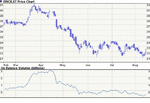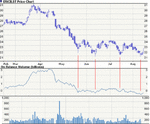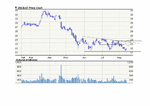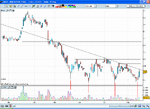Well, let's try this, keeping in mind that OBV is an indicator and not a line representation of the actual volume.
When I became interested in Wyckoff, I began doing this for both price and volume as a means of focusing on the waves rather than being thrown off by micro-managing the minutiae of individual bars. Since you appear to have interpreted the character of this base correctly, you may be picking this up by osmosis (or you may be making a conscious effort at it).
Note here that when price makes its second trip down, volume (i.e., trading activity) is about the same or slightly lower. You know buyers are coming in because price rises (and rises nicely). You know sellers aren't especially eager to push price lower because trading activity is no higher than it had been the first try. When price makes its third trip down, its trough is higher, and so is the trading activity trough. This is consistent with an observation that buying pressure is outweighing selling pressure on two fronts: the level of trading activity and the movement of price.
When price makes its fourth and perhaps last attempt, it makes a lower trough, but so does volume, suggesting that sellers are truly done, at least for now. At this point, it's up to the buyers. Can they push price out of this range, or do they encounter further resistance at the top of the range? Nothing to do about that but stay tuned.
All of this is easier to see if you replace price with a 1p MA or with a line-on-close option. This enables you to see the price waves, if you want to, and better evaluate them with regard to the OBV plot. Just a suggestion, if you're going to continue to incorporate volume.
Db







